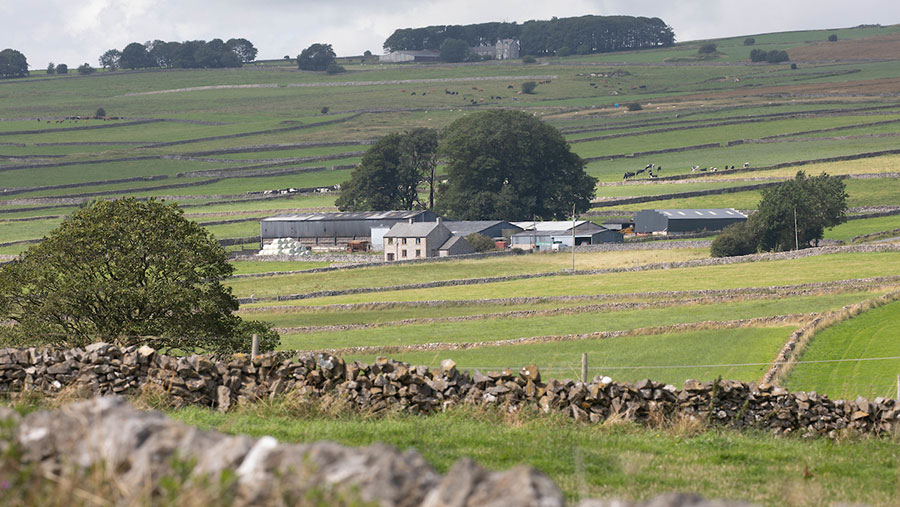5 crucial things government should include in ELM scheme
 © Tim Scrivener
© Tim Scrivener Future policy should reward British farmers for their pivotal role in maintaining and improving the nation’s iconic landscapes and countryside access, according to an NFU report.
The Landscape and Access report highlights how much farmers contribute to the countryside and environment.
See also: Green scheme payments ‘must fairly reward farmers’
It also calls on the government and stakeholders to develop farm and environmental policies that allow farmers to continue with this vital work and service.
Five key points for policymakers to consider and adopt
1. Every farmer has a contribution to make. The final version of the Environmental Land Management (ELM) scheme must:
- Be open and accessible to all farmers
- Be simple to access
- Provide fair reward for maintaining and improving landscape features and access
2. Where landscape-scale impact is the aim, government should ensure projects are developed and led by farmers to harness their local knowledge.
3. Incentives should be offered for the conservation and enhancement of carbon resources to help deliver agriculture’s net zero target.
4. Protected landscape bodies should actively recognise and enable the thriving, viable farm businesses that manage the landscape.
5. A modern and adaptable public access network that meets the needs of users and farm businesses should be developed.
Source: NFU Land and Access report
Speaking at the report launch on Tuesday (14 October), NFU president Minette Batters said farmers had maintained the countryside, supported rural economies and provided high-quality food.
“Our working landscapes will continue to change, but the one constant is those farmers who manage and shape this land,” Mrs Batters said.
“Features such as hedges, trees, cattle grazing fields and crops, all contribute to the wonderfully varied landscapes we see today.”
Farming’s contribution to the environment and landscape
- 70% of the rural landscape is managed by farmers
- 225,000km of public rights of way cross farmland in England and Wales
- 411,000km of hedgerows are maintained by farmers in England and Wales
- 48% of visits to the natural environment in England, totaling 4.1bn each year, are to farmland
- 28% of woodland and forestry (1.6m ha in England and Wales) is on farms
- 38,000 farm buildings in England have listed status
- 95,000km of stone walls are maintained by farmers
- 13.3m lone trees exist on farms outside woodland
- 500,000 ponds support wildlife on British farms
Source: NFU Land and Access report
These contributions are all a direct result of farmers’ dual roles as food producers and custodians of our countryside, said Ms Batters.
But maintaining important landscape features, such as flower-rich grassland or traditional farm buildings, carry significant costs.
Landscape management costs and benefits varied by location, soil type and farming system and are hard to calculate, the report states.
For example, every £1 invested in maintenance of dry stone walls returns £4.91 in benefits.
The benefits are also derived from cultural services such as tourism, the provision of habitat and contributions to biodiversity.
Yet, the report states that these are all benefits for which the farmer obtains no reward. And it points out that incentives could produce results.
Almost three-quarters (70%) of work carried out in areas farmed under environmental stewardship are to maintain landscape features that would otherwise have declined.
On public access, a national annual survey by Natural England is referenced, which provides valuable data on how the public in England engaged with nature.
The 2018-19 survey showed there was a sustained upward trend over many years in the number of people visiting the countryside, with 65% of adults doing so at least once a week in 2018-19.
People gained more enjoyment and positive wellbeing from visiting the coast and countryside than from urban parks, the survey found.
Covid release
Ms Batters said the countryside’s contribution to the nation’s wellbeing had been brought into sharp focus during the Covid-19 lockdown.
The pandemic has been a game-changer in the public’s appreciation of the countryside as people flocked there. People in greater numbers than ever before have been using the footpath network for their mental health and wellbeing, Ms Batters added.
Concluding, Ms Batters suggested that rewarding farmers for the work they did to protect and enhance the rural landscape made economic sense. It also ensured those with the expertise to do the work, stayed on the land.
“We are at a pivotal time for the future of farming and the countryside. We are already doing so much for the environment, but with the right policies in place we can do much more,” she said.
“Whether it is incentives to conserve carbon through the soil, manage bigger hedgerows or plant more woodland, we need policies that ensure we have a farmed environment that can feed the nation and thrive with wildlife.”
